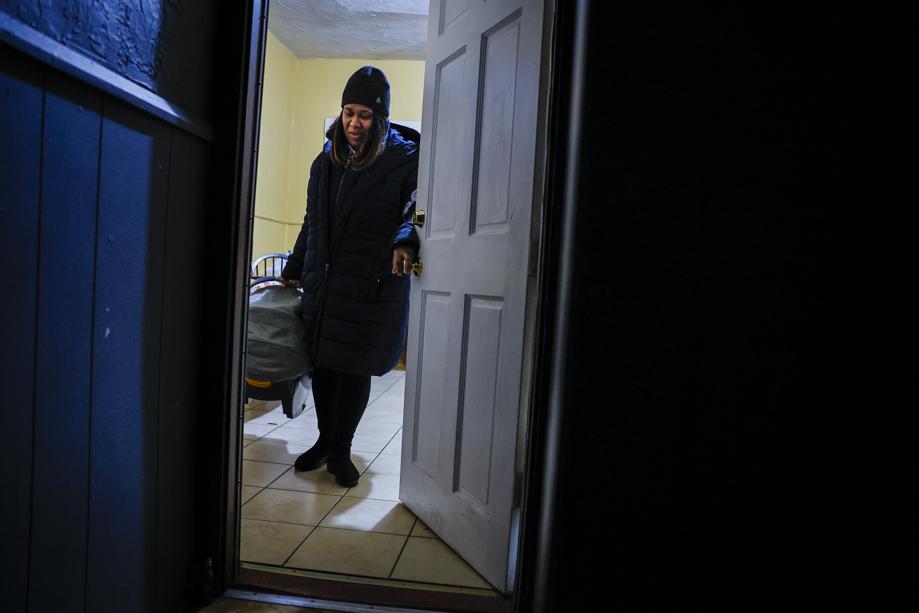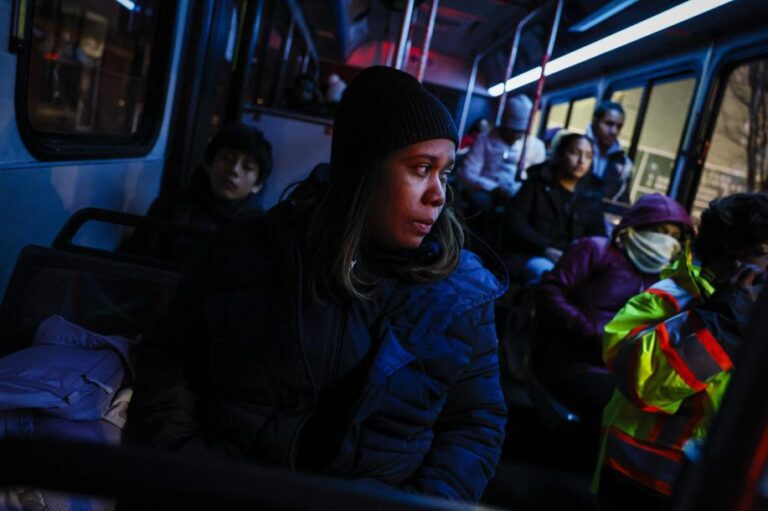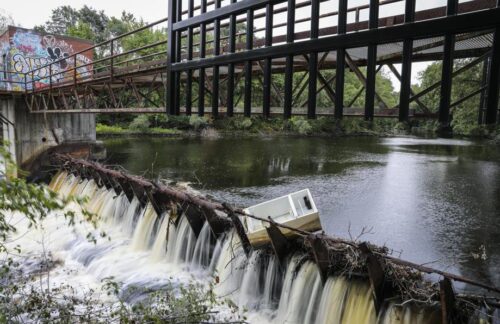
BROCKTON — Two minutes turned into five as people huddled near the bus stop shelter at the Westgate Mall waiting for the 4A bus.
Estefanis S. glanced at her phone impatiently. The bus, which runs every 30 minutes, was delayed, and she was already running behind picking up her 8-month-old from a friend’s house.
“You gotta catch [the bus] at the right time,’’ Estefanis, 30, said in Spanish, as she waited at the bus stop near her work. (Estefanis asked the Globe to use her middle name due to her immigration status.) Because of the bus schedule, if she missed one she would have to spend another half-hour in the winter cold.
Estefanis’s situation illustrates a growing tension in Brockton. As more low-income and middle-class workers move here seeking affordable housing, Brockton officials are grappling with how to provide reliable transit throughout the city and into the Greater Boston region. A recent free-fare program has helped lure more riders, but infrequent buses and longer commutes, as well as an expensive commuter rail system, continue to make public transportation inaccessible to many residents.
“We’re not a wealthy community in terms of our financial ledger,’’ said Mayor Robert Sullivan. “Our No. 1 wealth is the people of Brockton, and they need transportation.’’
In the last decade, Brockton’s population has grown about 12 percent, from roughly 93,000 people to more than 105,000. At the same time, it’s become home to many middle-class Black and Latino families looking to settle in a city where home prices are far less than what Boston has to offer. Over the years, waves of immigrants have made the city home. By some estimates, Brockton has the largest Cape Verdean population in the United States. The median household income in Brockton is north of $77,000, far short of the state’s $101,000 median.
“Most [workers], 90 percent of them depend on public transit,’’ said Isabel Lopez, executive director of the Brockton Workers Alliance, an organization serving many lower-income Haitian, Hispanic, and Cape Verdean workers in the city.
“Having a more reliable and affordable transportation that goes to different cities is so important and needed here,’’ Lopez said.
City and transit officials in Brockton have worked to address the growing demand. In 2023, after getting a $1.4 million grant from the state, city and Brockton Area Transit officials announced bus fare would be free for six months, in an effort to get more riders and ease access. The program was so successful, it was extended through June. Ridership has doubled since 2023, and over the next year, BAT officials said they expect to collectively provide around 4 million trips.
But funding for the free-fare program is running dry, and the city will have to end it if officials cannot find a long-term solution. The result, officials said, would likely be a drop in ridership. For his part, Sullivan said he has asked transit administrators to “turn over every rock for grant funding.’’
Some residents said they are thankful for saving on fare but see room for improvement.
“[Free buses are] really good for us, especially those who don’t have a car,“ said Pat Mask, 75, as she waited for the 14 bus. Mask said she lives on a fixed income and relies on public transit to get to her medical appointments. She appreciates saving on fare but still wishes her bus was more frequent, especially on weekends when it comes once an hour.
Chuck Daxbelgel, 79, said he’s been taking BAT for over 15 years, and has noticed the uptick in riders in recent years now that fares are gone.
“Naturally, everybody takes it now,’’ Daxbelgel said. “I don’t blame them. It’s good that it’s free, because this is a poor town,’’ he added as he prepared to take the commuter train to South Station. Even though it costs a bit more, it’s faster than taking the bus to Ashmont and then taking the subway, he said.
The BAT has started offering Sunday morning service and doubled the frequency of trips on Saturdays. On weekdays, buses run through 9 p.m. To meet the needs of late-night riders, officials say they will soon launch a pilot program that will subsidize ride-shares, allowing people who need a ride between 9 p.m. and 6 a.m. to be eligible for a $9 subsidy one way.
“We try to fill in gaps,’’ said Michael Lambert, administrator of the BAT. While the program details are being finalized, he expects it will start in March.
Though Brockton has three commuter rail stations, the reality is that it can be too expensive for some residents: Tickets are about $18 a day roundtrip, more than what some-minimum wage workers make in an hour. Currently, one bus connects Brockton to the Ashmont MBTA station — and it’s by far the most popular route, taking roughly 45 minutes depending on traffic.
“The people who are taking my bus to the Red Line are doing so because they can’t afford commuter rail,’’ Lambert said. “There’s no other reason to take my bus.’’
Such efforts are part of a larger push by the state to increase ridership and access across regional transportation agencies, and to support a system that has suffered from years of underfunding.
Regional transit agencies such as Brockton’s receive funding from a mix of sources: The state provides about 40 percent, local communities contribute about 30 percent through fares and city budgets, and the rest comes from federal dollars. Since much of those dollars come from annual budget allocations, funding varies year to year, making it difficult to plan long term.
Earlier this month, Governor Maura Healey announced an $8 billion effort to fund the state’s roads, bridges, and transportation systems, including $110 million marked for regional transit. State legislators have yet to approve funding but part of Healey’s efforts have also focused on fare-free buses, which have shown promising results, especially among the state’s regional transit systems, some of which have seen ridership reach beyond pre-pandemic levels.
The Southeastern Regional Transit Authority serving Plymouth and Bristol counties, for example, found ridership grew a dozen times faster than that of two neighboring transit systems — the Cape Cod Regional Transit Authority and the Greater Attleboro Taunton Regional Transit Authority — once it removed fares.
That’s helpful for many, but transit is only as good as what’s offered, administrators acknowledge.
“Even if it’s free, if it’s not good, people aren’t going to take it,’’ Lambert said. “If they can’t rely on it to work — that’s sort of our measure — or to their doctor’s appointment on time, they’re not going to take it.’’
At Father Bill’s, a nonprofit that offers emergency shelter and other services to people experiencing homelessness, transit is vital to help the people they work with secure employment and permanent housing.
“We see people getting jobs, but then having the inability to get there because they’re not in a transit-oriented area,’’ said John Yazwinski, president and CEO of the organization, who said it is currently serving about 160 people a night.
The organization, which recently opened a new shelter this year, has worked with city officials to get a bus stop added to the new location, a boost to the people Yazwinski serves.
Ana Ortet, a 53-year-old originally from Cape Verde, takes transit to get from Randolph to Boston, where she works caring for an older resident. She also relies on the BAT to make it to class and finds that because many of the bus stops don’t have shelter, she ends up waiting in the winter weather, sometimes for a half hour.
“On your way out, you don’t worry as much because you’re on your way home,’’ Ortet said, but “when you have to take more than one bus, it’s hard.’’
To make it to work on time, she sometimes takes a $12 Uber, which can jump to $17 depending on surge pricing.
But one way or another, Ortet has to move. She has places to be.
Esmy Jimenez can be reached at esmy.jimenez@globe.com. Follow her @esmyjimenez.


